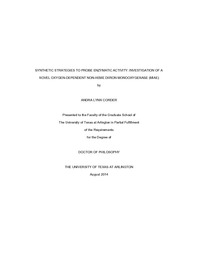
ATTENTION: The works hosted here are being migrated to a new repository that will consolidate resources, improve discoverability, and better show UTA's research impact on the global community. We will update authors as the migration progresses. Please see MavMatrix for more information.
Show simple item record
| dc.contributor.author | Corder, Andra Lynn | en_US |
| dc.date.accessioned | 2014-09-17T17:30:00Z | |
| dc.date.available | 2014-09-17T17:30:00Z | |
| dc.date.issued | 2014-09-17 | |
| dc.date.submitted | January 2014 | en_US |
| dc.identifier.other | DISS-12742 | en_US |
| dc.identifier.uri | http://hdl.handle.net/10106/24747 | |
| dc.description.abstract | Within the anticodon stem loop (ACSL) of tRNA, nucleoside modifications are frequently observed at position 34 (the wobble position) or position 37 (3' adjacent to the anticodon). For instance, nearly all eukaryotic and bacterial tRNAs that read codons starting with uridine are modified by the enzymes MiaA and MiaB. While absent in eukaryotes, some facultative bacteria utilize a non-heme diiron enzyme (MiaE) to catalyze the O2₂-dependent hydroxylation of 2-thiomethyl-N₆-(3-methyl-2-butenylamino) adenosine (ms²i⁶A₃₇) to produce 2-methylthio-N⁶-(4-hydroxyisopentenyl)-adenosine (ms²io⁶A₃₇). In these bacteria, it has been postulated that the extent of the A37-hydroxylation is involved in regulating aromatic amino acid uptake, iron transport, and aerobiosis. The following dissertation details the synthesis of several modified substrate surrogates and their application toward characterizing the active site of MiaE. Chapter 1 reviews tRNA modifications and the enzymology of MiaE. MiaA and MiaB are briefly discussed, followed by a more detailed review of MiaE activity, catalysis, and spectroscopy. Chapter 2 details the characterization of the chemo- and stereospecificity of MiaE using three synthetic β-nucleoside substrates [2-thiomethyl-N⁶6-(3-methyl-2-butenylamino) adenosine (ms²i⁶A); N⁶-(3-methyl-2-butenylamino) adenosine (i⁶A); and 2-chloro-N⁶-(3-methyl-2-butenylamino) adenosine (Cl²i⁶A)]. Remarkably, regardless of the substrate used in peroxide-shunt assays, hydroxylation of the isopentenyl-C4-position was observed with > 97% E-stereoselectivity. Moreover, the initial rate of MiaE hydroxylation is highly influenced by the substituent at the C2-position of the nucleoside base [v0/[E] for ms²i⁶A > i⁶A > Cl²i⁶A]. Chapter 3 describes the construction of modified substrate-surrogate spin-probes employed to further interrogate the role of the C2-functionality. Beyond creating a tool to study the enzymes binding pocket, the synthetic strategy targeted the smooth coupling of three subunits (base, ribose, and spin-probe) so that the methodology could be easily used for the investigation of a wide range of biomolecular targets. Chapter 4 details several proposed experiments to aid in further dissecting the active site of MiaE through the synthesis of new substrates and further biophysical analysis. Lastly, Chapter 5 is a brief chapter describing the optimization of a Mitsunobu-like process catalytic in phosphine. | en_US |
| dc.description.sponsorship | Foss, Frank | en_US |
| dc.language.iso | en | en_US |
| dc.publisher | Chemistry & Biochemistry | en_US |
| dc.title | Synthetic Strategies To Probe Enzymatic Activity: Investigation Of A Novel Oxygen-dependent Non-heme Diiron Monooxygenase (MiaE) | en_US |
| dc.type | Ph.D. | en_US |
| dc.contributor.committeeChair | Foss, Frank W. | en_US |
| dc.degree.department | Chemistry & Biochemistry | en_US |
| dc.degree.discipline | Chemistry & Biochemistry | en_US |
| dc.degree.grantor | University of Texas at Arlington | en_US |
| dc.degree.level | doctoral | en_US |
| dc.degree.name | Ph.D. | en_US |
Files in this item
- Name:
- Corder_uta_2502D_12742.pdf
- Size:
- 5.753Mb
- Format:
- PDF
This item appears in the following Collection(s)
Show simple item record


